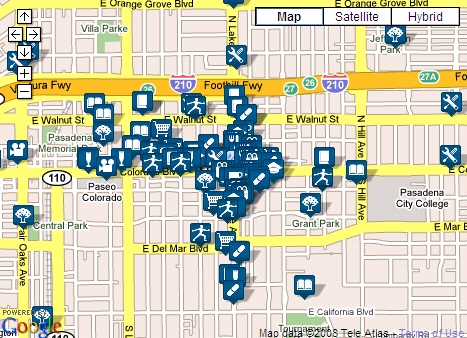I have always known that one of the most appealing elements of Pasadena is that many of its neighborhoods are extremely walkable. Now, there’s a wonderful website that collects information of cities across the country and has ranked 2,508 neighborhoods based on their “walkability”.
Wbalkscore.com is a website that looks at “walkability” of a particular neighborhood. It helps people find walkable places to live. With gas prices going through the roof and the health benefits of walking, this website calculates the walkability of an address by locating nearby stores, restaurants, schools, parks, etc. Walk Score measures how easy it is to live a car-lite lifestyle-not how pretty the area is for walking.
Why Walking Matters
Walkable neighborhoods offer surprising benefits to our health, the environment, and our communities.
Better health: A study in Washington State found that the average resident of a pedestrian-friendly neighborhood weighs 7 pounds less than someone who lives in a sprawling neighborhood.1 Residents of walkable neighborhoods drive less and suffer fewer car accidents, a leading cause of death between the ages of 15-45.
“We are here to show those guys that are inching their way on the freeways in their metal coffins that the human spirit is still alive.”
– Patrick Swayze, Point Break
Reduction in greenhouse gas: Cars are a leading cause of global warming. Your feet are zero-pollution transportation machines.
More transportation options: Compact neighborhoods tend to have higher population density, which leads to more public transportation options and bicycle infrastructure. Not only is taking the bus cheaper than driving, but riding a bus is ten times safer than driving a car!2
Increased social capital: Walking increases social capital by promoting face-to-face interaction with your neighbors. Studies have shown that for every 10 minutes a person spends in a daily car commute, time spent in community activities falls by 10%.3
Stronger local businesses: Dense, walkable neighborhoods provide local businesses with the foot traffic they need to thrive. It’s easier for pedestrians to shop at many stores on one trip, since they don’t need to drive between destinations.
Walkable Neighborhoods
Picture a walkable neighborhood. You lose weight each time you walk to the grocery store. You stumble home from last call without waiting for a cab. You spend less money on your car-or you don’t own a car. When you shop, you support your local economy. You talk to your neighbors.
What makes a neighborhood walkable?
- A center: Walkable neighborhoods have a discernable center, whether it’s a shopping district, a main street, or a public space.
- Density: The neighborhood is compact enough for local businesses to flourish and for public transportation to run frequently.
- Mixed income, mixed use: Housing is provided for everyone who works in the neighborhood: young and old, singles and families, rich and poor. Businesses and residences are located near each other.
- Parks and public space: There are plenty of public places to gather and play.
- Pedestrian-centric design: Buildings are placed close to the street to cater to foot traffic, with parking lots relegated to the back.
- Nearby schools and workplaces: Schools and workplaces are close enough that most residents can walk from their homes.
Streets Designed for Everyone
Complete Streets are roads are designed for everyone who uses them, including bicyclists, pedestrians of all ages and abilities, and people getting on and off transit vehicles. These streets are:
- Accessible: There are wheelchair ramps, plenty of benches with shade, sidewalks on all streets, etc.
- Well-connected: Streets form a connected grid that improves traffic by providing many routes to any destination.
- Built for the right speed: Lanes are narrow or traffic calming is in place to control speed.
- Comfortable: Pedestrian medians at intersections, count-down crosswalk timers, bicycle lanes, protected bus shelters, etc. make the street work better for those outside of a car.
So where does Pasadena stand?
I am happy to report that Pasadena’s walk score is 98 out of 100! – Pasadena is truly a Walker’s Paradise.
Your Walk Score is a number between 0 and 100. Here are general guidelines for interpreting the score:
- 90-100 = Walkers’ Paradise: Most errands can be accomplished on foot and many people get by without owning a car.
- 70-89 = Very Walkable: It’s possible to get by without owning a car.
- 50-69 = Somewhat Walkable: Some stores and amenities are within walking distance, but many everyday trips still require a bike, public transportation, or car.
- 25-49 = Car-Dependent: Only a few destinations are within easy walking range. For most errands, driving or public transportation is a must.
- 0-24 = Car-Dependent (Driving Only): Virtually no neighborhood destinations within walking range. You can walk from your house to your car!
Of course, I didn’t need to see Pasadena’s walk score. I’ve been walking Pasadena for a long time. How about you?
Interested in learning more about Pasadena? If so, take a look at our 365 Things To Do In Pasadena® page or join us on facebook.


